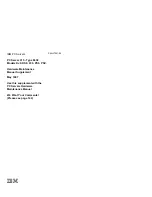
889-3819-00
MMU2-1600GE series Operations Manual Rev Apr 2020 Page
19
of 51
Tests Modified:
+24 Volt Monitor II
: 24 Volt Monitor II testing checks for the +24V Monitor II (Connector B - Pin R)
input being greater than +22V
DC
. When this feature is enabled, a voltage greater than +11.5V
DC
applied to the +24
Volt Monitor II input is recognized as adequate for proper operation. A voltage of less than +10.75V
DC
applied to
the +24 Volt Monitor II input is recognized as inadequate for proper operation.
Typical Use
: This feature can be very useful in TS 2 cabinets with 12 VDC supplies. The monitor can now
monitor a +12 VDC supply as well as a +24 VDC supply. The operation of the input is the same as if it were the
+24V Monitor II; except the voltage levels are changed.
2.6.8
DISABLE LOCAL FLASH
Configuration:
The setting of Disable Local Flash determines if this feature is active. The testing default for this
feature is set to no.
Tests Modified:
Local Flash
: Normal intersection operation requires that the Local Flash input (Connector B - Pin c) be greater
than +22V
DC
. When this feature is enabled, the Local flash input is ignored and normal intersection operation is
allowed.
Typical Use
: This feature is useful when it is desirable to ignore a command to begin flash operation of the
intersection. This may come from a Time Clock or an output of the Controller that is controlled by Time Of Day,
Coordination, a System Master, or Police Panel.
2.6.9
FLASHING GREEN (CANADIAN FAST FLASH)
Configuration:
This is a factory option and cannot be changed by the user. If this function is required but it is not
active, contact Reno A&E Technical Support for assistance. This feature is set to OFF for units sold in the United
States and set to ON for units shipped to Canada.
Tests Modified:
Please refer to Reno A&E Application Note AN-004 in the Support section of the Reno A&E web site
(renoae.com) under Monitor Support / Application Notes for a detailed description of how these tests are modified.
Red Fail
: Red Fail Fault time is changed from 800 milliseconds to 1.5 seconds. Red Fail Reset time is changed
from 300 milliseconds to 200 milliseconds.
Dual Indication
: Green-Yellow Dual Indication Reset time is changed from 300 milliseconds to 100 milliseconds.
Green-Red Dual Indication Reset time is changed from 300 milliseconds to 100 milliseconds
Typical Use
: This feature is intended to support the use of flashing Green indications as used in Canada.
2.6.10
CHANNELS WITH PEDESTRAIN DISPLAYS
Configuration:
The setting of Channels with Pedestrian Displays determines if this feature is active on a per
channel basis. The testing default for this feature is set to no channels active.
Tests Modified:
Red Fail
:
Affects Type 12 operation only
. Normal red fail testing ensures that at least a red, yellow, green, or
walk display is active for a channel. Any channel with a setting of “Y” for Channels with Pedestrian Displays will
not include the walk display in the testing for red fail faults on that channel.
Dual Indication
: Normal dual indication testing uses 600 milliseconds as the fault time for Red dual
indications. Any channel with a setting of “Y” for Channels with Pedestrian Displays will use 800 milliseconds as
the fault time for Red dual indications.
Typical Use
: In Type 12 mode of operation, this feature allows vehicle displays to be checked for a dark head even
though a walk for the channel may be active. In Type 16 mode of operation, this feature allows for a longer
Red dual indication fault time to deal with some controllers that have a slight overlap between the
pedestrian clearance interval and the don’t walk interval of a pedestrian channel.
2.7
EVENT LOGGING
Six different Event Logs provide detailed, date and time stamped documentation of selected events recorded by the
monitor. This data is useful in troubleshooting and provides an accurate historical record of cabinet operation.
When the date and time are not available through Port 1, the monitor will use its internal Real Time Clock as a date
/ time stamp for events.
2.7.1
TIME CHANGE LOG
The Time Change Log records the 50 most recent time changes. Data recorded: Original Date / Time Stamp, New
Date / Time Stamp, and Up Time Accumulator.
















































